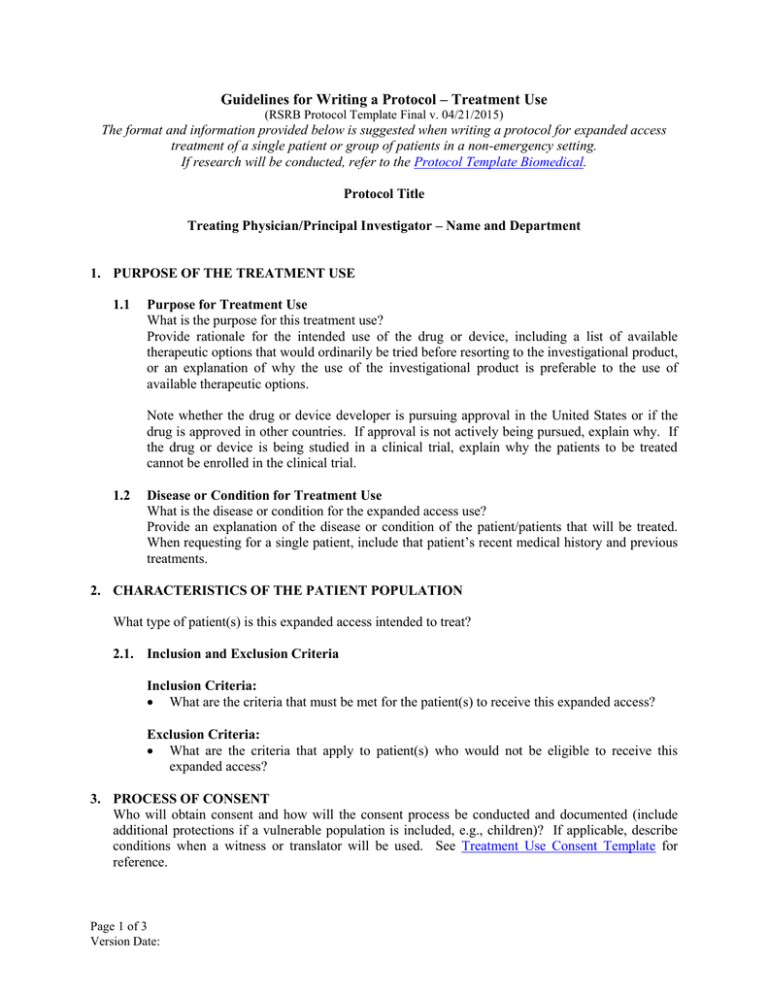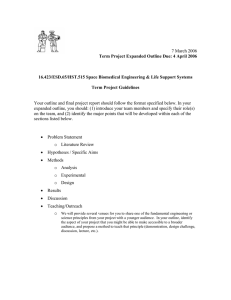Protocol Template Treatment Use
advertisement

Guidelines for Writing a Protocol – Treatment Use (RSRB Protocol Template Final v. 04/21/2015) The format and information provided below is suggested when writing a protocol for expanded access treatment of a single patient or group of patients in a non-emergency setting. If research will be conducted, refer to the Protocol Template Biomedical. Protocol Title Treating Physician/Principal Investigator – Name and Department 1. PURPOSE OF THE TREATMENT USE 1.1 Purpose for Treatment Use What is the purpose for this treatment use? Provide rationale for the intended use of the drug or device, including a list of available therapeutic options that would ordinarily be tried before resorting to the investigational product, or an explanation of why the use of the investigational product is preferable to the use of available therapeutic options. Note whether the drug or device developer is pursuing approval in the United States or if the drug is approved in other countries. If approval is not actively being pursued, explain why. If the drug or device is being studied in a clinical trial, explain why the patients to be treated cannot be enrolled in the clinical trial. 1.2 Disease or Condition for Treatment Use What is the disease or condition for the expanded access use? Provide an explanation of the disease or condition of the patient/patients that will be treated. When requesting for a single patient, include that patient’s recent medical history and previous treatments. 2. CHARACTERISTICS OF THE PATIENT POPULATION What type of patient(s) is this expanded access intended to treat? 2.1. Inclusion and Exclusion Criteria Inclusion Criteria: What are the criteria that must be met for the patient(s) to receive this expanded access? Exclusion Criteria: What are the criteria that apply to patient(s) who would not be eligible to receive this expanded access? 3. PROCESS OF CONSENT Who will obtain consent and how will the consent process be conducted and documented (include additional protections if a vulnerable population is included, e.g., children)? If applicable, describe conditions when a witness or translator will be used. See Treatment Use Consent Template for reference. Page 1 of 3 Version Date: 4. TREATMENT PROCEDURES 4.1. Treatment Administration What is the proposed method of administration of the drug or device, the dose, and duration of therapy? 4.2. Efficacy Assessments What assessments will be conducted to evaluate efficacy? 4.3. Safety Assessments What assessments will be conducted to assess and monitor patient safety? 4.4. Costs to the Patient What costs is the patient or the patient’s insurance responsible for as a result of receiving this expanded access treatment (e.g., drug, standard of care procedures)? 5. CONCOMITANT AND DISALLOWED MEDICATIONS Indicate whether there are any medications or treatments that should not be used in conjunction with the drug or device being provided as part of this expanded access. 6. WITHDRAWAL FROM TREATMENT Indicate that patients will be advised in the written informed consent forms that they have the right to withdraw from the treatment at any time without prejudice. 7. DESCRIPTION OF DRUG/DEVICE [Note: The IB/package insert/device information sheet, as applicable, should be included in Section 50 of the RSRB application.] Provide a description of the drug, device, or biologic that will be used for this expanded access. Indicate that a treatment IND has been obtained and the number. Indicate how the product will be supplied. Describe plans for control of the drug/device by indicating who will be responsible for receipt, storage, dispensing, collection, accountability and disposal of the drug/device to be used for the expanded access (e.g., the pharmacist). 8. SAFETY AND REPORTABLE EVENTS 8.1. Recording Adverse Events The following shaded text is recommended wording, as applicable: At the treatment visit, the patient will be questioned regarding the occurrence of any adverse experience. Staff will also assess adverse events by recording all voluntary complaints of the patient and by assessment of clinical and laboratory features. All adverse events will be documented. 8.2. Responsibilities for Reporting Serious Adverse Events The Treating Physician should record all serious adverse experiences that occur during the conduct of the treatment protocol. Note that Sponsor-Investigator regulatory reporting responsibilities may apply if the UR Treating Physician is the holder of the Treatment IND/IDE. Page 2 of 3 Version Date: 9. RISK/BENEFIT ASSESSMENT 9.1. Potential Risks Describe the potential risks associated with the drug/device to be used for the expanded access, including any specific toxicity data noted in the Investigator’s Brochure/package insert. 9.2. Protection Against Risks Describe any methods for preventing and/or minimizing any potential risks or discomfort. 9.3. Potential Benefits Describe potential direct benefit(s), if any, for being treated under this protocol. 10. CONFIDENTIALIATY OF DATA AND INFORMATION STORAGE Indicate how the patient’s data will be collected, identified, stored, and securely maintained. Explain how you will protect against disclosure of individual patient identifiers. Indicate who will have access to the data. If data with patient identifiers will be released outside of the covered entity, specify the person(s) or agency to whom the information will be released and the purpose of the release. 11. REFERENCES Provide complete, numbered references for all citations listed in the order that they appear. Page 3 of 3 Version Date:
